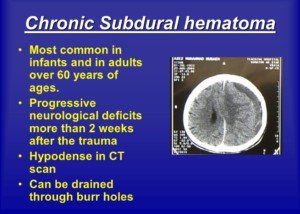
In younger adults, how common is it that a chronic subdural hematoma would not cause a headache?
A subdural hematoma is bleeding under the dura mater of the brain. This can begin happening several weeks to a few months after the head trauma — at which point symptoms would begin appearing.
Younger people with a chronic subdural hematoma are much more likely than elderly people to experience a headache from this condition.
This is because the younger brain has not shrunken, and thus, the space between the brain and the dura mater is very tight.
If bleeding begins occurring between this very confined space, it will create a pressure that usually results in a very bad headache.
This space is a lot bigger when the brain is shrunken (atrophied) —which usually occurs with the elderly brain.
Headache and Chronic Subdural Hematoma
“In young people, the chronic subdural hematoma is usually caused by some kind of traumatic injury to the brain,” explains Charles Park, MD, Director of The Minimally Invasive Brain and Spine Center at Mercy Medical Center in Baltimore.
Dr. Park continues, “The extent of the injury can be a mild concussion to severe contusion and bleeding into the brain and outside the brain.
“Headache is the most common symptom, but others, such as nausea/vomiting, cognitive impairment, slurred speech, visual disturbance are expected as well in that order of increasing severity.”
Summary
Headaches most commonly occur in younger people as a symptom of a chronic subdural hematoma. But younger adults can still experience other symptoms.
And likewise, an elderly person with this condition may suffer a searing headache despite more space between the aged brain and the dura mater.
The percentage of people under age 60 who have a headache resulting from a chronic subdural hematoma is estimated to be up to 80 percent.
The key words are “up to.” Data on this percentage is not exact. We cannot say, for instance, that 80 percent have headaches.
Usually, the percentage is a range that starts under 50 percent and goes up to 80.
Dr. Park specializes in minimally invasive surgical techniques for treatment of conditions affecting the brain and spine. He’s skilled in advanced procedures and techniques that utilize innovative computer technology and image-guided surgery systems.
 Lorra Garrick has been covering medical, fitness and cybersecurity topics for many years, having written thousands of articles for print magazines and websites, including as a ghostwriter. She’s also a former ACE-certified personal trainer.
Lorra Garrick has been covering medical, fitness and cybersecurity topics for many years, having written thousands of articles for print magazines and websites, including as a ghostwriter. She’s also a former ACE-certified personal trainer.
.










































